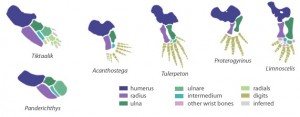How many fingers do you have? Hopefully, 5. Do you think that’s the normal condition for all animals? Do you think that’s air you’re breathing right now? … OK, so I watched the Matrix last night, but still, do you think all tetrapods (dudes with 4 feet, including you, and anything else with four flippers, wings, or feet) have 5 digits on each limb? Actually, there’s a pattern within tetrapods of limb reduction in various lineages – our earliest ancestors seemed to experiment with digit numbers and went a bit berserk by growing extra fingers from their fishy flippers.
DINOSAUR! But what does it mean..?
Palaeontology probably isn’t the most difficult of sciences, but it does incorporate aspects of chemistry, biology, and physics to a certain degree, as with many other geoscientific disciplines. Palaeontologists are also well known for the mysterious and unintelligible ‘science-speak’ that they use in research papers, fueled by this combination of a multitude of various sciences, the insane taxonomic system that we employ to identify fossils, and the standard anatomical descriptive phrasing too. I guess the aim of this series of posts, is just to break down some of the more complex terminology that you may come across online or in papers, and gain a bit more of an understanding of Palaeontology and related fields in the process. Yeah, it’s pretty much a glossary. With dinosaurs. Suggestions for words welcomed!

